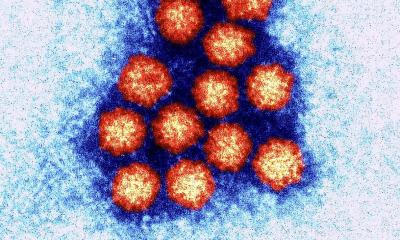Image source: Gudrun Holland, N. Bannert/RKI
News • Survey on pathogens of concern
What will cause the next pandemic? Experts agree on a likely culprit
New research presented at the ESCMID Global Congress (formerly ECCMID) in Barcelona, Spain (27-30 April) shows that in a VACCELERATE Consortium survey study in which infectious diseases experts were asked to rank pathogens in order of their pandemic potential, influenza was considered the pathogen of highest pandemic risk, with 57% ranking influenza as number one, and a further 17% ranking it second.
The study is by Dr Jon Salmanton-García, University of Cologne, Faculty of Medicine and University Hospital Cologne, Institute of Translational Research, Cologne Excellence Cluster on Cellular Stress Responses in Aging-Associated Diseases (CECAD), Cologne, Germany, and colleagues from across Europe, and published in the journal Travel Medicine and Infectious Disease.
Other highly ranked pathogens included Disease X (as yet unknown disease) with 21% ranking this number one and 14% second. Sars-CoV-2 was third in terms of number one responses on 8%, with 16% voting it number two, while the original Sars-CoV virus that circulated in 2002-03 was voted number one by 2% of respondents and second by 8%. Crimean-Congo haemorrhagic fever virus (CCHF virus) and Ebola virus were joint fifth, with 1.6% respondents voting them first. Nipah virus, henipavirus, and Rift Valley fever virus were among the pathogens ranked lowest in terms of their perceived pandemic potential.
Every winter there are little [influenza] pandemics. They are more or less controlled because the different strains are not virulent enough. [...] In case a new strain becomes more virulent, this control could be lost
Jon Salmanton-García
The World Health Organization (WHO) has outlined a comprehensive Research and Development (R&D) Blueprint for Action to Prevent Epidemics, focusing on key infectious diseases that pose significant threats to public health. These diseases were selected after rigorous evaluation, taking into account factors like transmissibility, infectivity, severity, and their potential for evolution. In alignment with the WHO's R&D Blueprint, the VACCELERATE Site Network (a pan-European network of sites collaborating on Covid-19, other infectious diseases and general pandemic preparedness for infectious diseases) engaged infectious disease experts from around the world, both among and outside its members, to rank the diseases listed in terms of their perceived risk of instigating a pandemic.
Participants were tasked with ranking various pathogens based on their perceived pandemic risk, encompassing diseases featured in the WHO R&D Blueprint and additional pathogens. Experts could rank up to 14 pathogens in the order of their perceived risk (the 13 pathogens listed plus Disease X -as yet unknown pathogen) in any order, and also suggest pathogens not listed to include in their maximum of 14. Each pathogen received a score based on its positions.
A total of 187 responses were collected from infectious disease experts hailing from 57 different countries. Among the countries providing the highest number of responses, Germany accounted for 27 replies (14%), followed by Spain with 20 replies (11%), and Italy with 14 replies (8%). Influenza viruses emerged as the most concerning pathogen with other highly ranked pathogens including Disease X, Sars-CoV-2, Sars-CoV, and the Ebola virus. Conversely, Hantavirus, Lassa virus, Nipah virus, henipavirus and Rift Valley fever virus were among the pathogens ranked lowest in terms of their pandemic potential.

Image source: University Hospital Cologne; photo: Christian Wittke
The authors conclude: “The study revealed that influenza, disease X, Sars-CoV-2, Sars-CoV, and the Ebola virus are the most worrisome pathogens concerning their pandemic potential. These pathogens are characterised by their transmissibility through respiratory droplets and a history of previous epidemic or pandemic outbreaks.”
Commenting on the top ranking of influenza, Dr Salmanton-García adds: “Each winter we have an influenza season. One could say that this means that every winter there are little pandemics. They are more or less controlled because the different strains are not virulent enough. Yet, every season the strains involved change, that is the reason why we can get influenza several times in life and vaccines change year to year. In case a new strain becomes more virulent, this control could be lost.”
But he adds the world is now much more prepared due to the Covid-19 pandemic, whereas before a lot of the focus had been on a potential influenza pandemic. He says: “In Covid-19 pandemic, we have learned many things on how to approach a respiratory virus pandemic. This includes social distancing, hand cleaning, face masks, a renewed focus on vaccination, and trust in healthcare institutions. In parallel, institutions have also learnt a lot. Preparedness and surveillance are now, vitally, better-funded.”
Source: European Society of Clinical Microbiology and Infectious Diseases
23.04.2024











